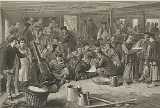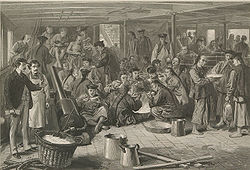
Mass migrations
Encyclopedia

Human migration
Human migration is physical movement by humans from one area to another, sometimes over long distances or in large groups. Historically this movement was nomadic, often causing significant conflict with the indigenous population and their displacement or cultural assimilation. Only a few nomadic...
of a large group of people from one geographical area to another. Mass migration is distinguished from individual or small scale migration; it is also different from seasonal migration
Seasonal human migration
Seasonal human migration is very common in agricultural cycles. It includes migrations such as moving sheep or cattle to higher elevations during summer to escape heat and find more forage...
, which occurs on a regular basis.
A specific mass migration that is seen as especially influential to the course of history may be referred to as a 'great migration'. Examples of great migrations include the Barbarian Invasions during the Roman Empire
Roman Empire
The Roman Empire was the post-Republican period of the ancient Roman civilization, characterised by an autocratic form of government and large territorial holdings in Europe and around the Mediterranean....
, the Great Migration from England
Great Migration (Puritan)
The Puritan migration to New England was marked in its effects in the two decades from 1620 to 1640, after which it declined sharply for a while. The term Great Migration usually refers to the migration in this period of English settlers, primarily Puritans to Massachusetts and the warm islands of...
of the 1630s, the California Gold Rush
California Gold Rush
The California Gold Rush began on January 24, 1848, when gold was found by James W. Marshall at Sutter's Mill in Coloma, California. The first to hear confirmed information of the gold rush were the people in Oregon, the Sandwich Islands , and Latin America, who were the first to start flocking to...
from 1848–1850, and the Great Migration of African Americans
Great Migration (African American)
The Great Migration was the movement of 6 million blacks out of the Southern United States to the Northeast, Midwest, and West from 1910 to 1970. Some historians differentiate between a Great Migration , numbering about 1.6 million migrants, and a Second Great Migration , in which 5 million or more...
from the rural American south to the industrial north during 1920–1950.
Historians often identify an 'age of mass migration', occurring from c. 1850 to 1914 (sometimes 1940), in which long distance migration occurred at an unprecedented and exceptionally high rate. There were three factors that led to the 'age of mass migration'. First, cost of migration decreased dramatically. Second, benefits of migration rise (returns on migration was higher in the US than in other countries). Third, open border regime. 'Age of mass migration' usually refers to the voluntary transatlantic migration
Transatlantic migrations
Transatlantic migration refers to the movement of people across the Atlantic Ocean in order to settle on the continents of North and South America. It usually refers to migrations after Christopher Columbus' voyage to the Americas in 1492...
of Europe
Europe
Europe is, by convention, one of the world's seven continents. Comprising the westernmost peninsula of Eurasia, Europe is generally 'divided' from Asia to its east by the watershed divides of the Ural and Caucasus Mountains, the Ural River, the Caspian and Black Seas, and the waterways connecting...
an peasants and labourers to the Americas
Americas
The Americas, or America , are lands in the Western hemisphere, also known as the New World. In English, the plural form the Americas is often used to refer to the landmasses of North America and South America with their associated islands and regions, while the singular form America is primarily...
. Immigration from Europe accounted for about 40% of total U.S. population growth in late 19th century. However, it has been argued that the term should include other mass migrations that occurred in the same period, since similar large numbers of people migrated long distances within the continent of Asia
Asia
Asia is the world's largest and most populous continent, located primarily in the eastern and northern hemispheres. It covers 8.7% of the Earth's total surface area and with approximately 3.879 billion people, it hosts 60% of the world's current human population...
, most notably during the Pakistan Movement
Pakistan Movement
The Pakistan Movement or Tehrik-e-Pakistan refers to the historical movement to have an independent Muslim state named Pakistan created from the separation of the north-western region of the Indian subcontinent, partitioned within or outside the British Indian Empire. It had its origins in the...
. During open border regime, immigrants attracted by falling costs of migration and higher wages in the U.S. Migrant selection varies over time and across sending country, depending on relative wage premium in U.S. for high/low skilled and cost of migration. In late 20th century, migrants converge upon native-born in labor market but never fully catch up.
Mass migration is not always voluntary, sometimes including forced migration
Forced migration
Forced migration refers to the coerced movement of a person or persons away from their home or home region...
, such as the Atlantic slave trade
Atlantic slave trade
The Atlantic slave trade, also known as the trans-atlantic slave trade, refers to the trade in slaves that took place across the Atlantic ocean from the sixteenth through to the nineteenth centuries...
.Religious persecution mass migrations,such as the biblical Exodus and migration through the upper Himalyan route from the east by Purohits of Aryan and non- Aryan descent. Similarly, mass migrations may take place in the form of deportation
Deportation
Deportation means the expulsion of a person or group of people from a place or country. Today it often refers to the expulsion of foreign nationals whereas the expulsion of nationals is called banishment, exile, or penal transportation...
; for example, Japanese internment in the United States and imprisonment in Nazi concentration camps
Nazi concentration camps
Nazi Germany maintained concentration camps throughout the territories it controlled. The first Nazi concentration camps set up in Germany were greatly expanded after the Reichstag fire of 1933, and were intended to hold political prisoners and opponents of the regime...
during World War II
World War II
World War II, or the Second World War , was a global conflict lasting from 1939 to 1945, involving most of the world's nations—including all of the great powers—eventually forming two opposing military alliances: the Allies and the Axis...
, deportations to Gulag
Gulag
The Gulag was the government agency that administered the main Soviet forced labor camp systems. While the camps housed a wide range of convicts, from petty criminals to political prisoners, large numbers were convicted by simplified procedures, such as NKVD troikas and other instruments of...
camps in the Soviet Union
Soviet Union
The Soviet Union , officially the Union of Soviet Socialist Republics , was a constitutionally socialist state that existed in Eurasia between 1922 and 1991....
, and coolie
Coolie
Historically, a coolie was a manual labourer or slave from Asia, particularly China, India, and the Phillipines during the 19th century and early 20th century...
-labour in Southeast Asia
Southeast Asia
Southeast Asia, South-East Asia, South East Asia or Southeastern Asia is a subregion of Asia, consisting of the countries that are geographically south of China, east of India, west of New Guinea and north of Australia. The region lies on the intersection of geological plates, with heavy seismic...
and the Caribbean
Caribbean
The Caribbean is a crescent-shaped group of islands more than 2,000 miles long separating the Gulf of Mexico and the Caribbean Sea, to the west and south, from the Atlantic Ocean, to the east and north...
.
See also
- Human migrationHuman migrationHuman migration is physical movement by humans from one area to another, sometimes over long distances or in large groups. Historically this movement was nomadic, often causing significant conflict with the indigenous population and their displacement or cultural assimilation. Only a few nomadic...
- Great Migration (disambiguation)
- Transatlantic migrationsTransatlantic migrationsTransatlantic migration refers to the movement of people across the Atlantic Ocean in order to settle on the continents of North and South America. It usually refers to migrations after Christopher Columbus' voyage to the Americas in 1492...
- Mass Migration (Band)
- Urbanization in ChinaUrbanization in ChinaUrbanization in the People's Republic of China increased in speed following the initiation of the reform and opening policy. By the end of 2010, the mainland of the People's Republic of China had a total urban population of 665.57 million or 49.68 percent of the total population.The rural-to-urban...

